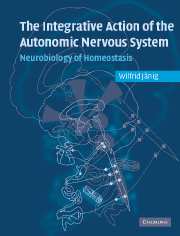Book contents
- Frontmatter
- Contents
- Foreword
- Preface
- List of abbreviations
- Introduction
- Part I The autonomic nervous system: functional anatomy and visceral afferents
- Part II Functional organization of the peripheral autonomic nervous system
- Part III Transmission of signals in the peripheral autonomic nervous system
- Chapter 6 Impulse transmission through autonomic ganglia
- Chapter 7 Mechanisms of neuroeffector transmission
- Part IV Central representation of the autonomic nervous system in spinal cord, brain stem and hypothalamus
- References
- Index
Chapter 7 - Mechanisms of neuroeffector transmission
Published online by Cambridge University Press: 10 August 2009
- Frontmatter
- Contents
- Foreword
- Preface
- List of abbreviations
- Introduction
- Part I The autonomic nervous system: functional anatomy and visceral afferents
- Part II Functional organization of the peripheral autonomic nervous system
- Part III Transmission of signals in the peripheral autonomic nervous system
- Chapter 6 Impulse transmission through autonomic ganglia
- Chapter 7 Mechanisms of neuroeffector transmission
- Part IV Central representation of the autonomic nervous system in spinal cord, brain stem and hypothalamus
- References
- Index
Summary
Impulse activity in the preganglionic neurons is the result of integrative processes in the spinal cord and brain stem (see Chapters 9 and 10). Such top down signaling (i.e. central message) is not usually distorted in the ganglia of the final autonomic pathways. It is modified by synaptic input from peripheral neurons in a few autonomic pathways to the viscera (see Subchapters 5.7 and 6.5). The central message is distributed to a large population of postganglionic neurons but confined to the respective autonomic pathways. Thus, transmission of impulses from preganglionic neurons to postganglionic neurons occurs within the same final autonomic pathway, but not between autonomic pathways. In this chapter I will discuss some mechanisms by which centrally generated messages are transmitted from postganglionic neurons to the target cells (effectors).
The mechanism of neuroeffector transmission varies considerably between target tissues. This is a consequence of there being many different types of cells innervated by postganglionic neurons (see Table 1.2). However, neuroeffector transmission has been studied in only a few cases. Such studies clearly demonstrate that the neural impulse activity is transmitted to the effector cells in a rather specific way and this may apply to all autonomically innervated effector cells. This view does not preclude the idea that the activity in some autonomic effector cells is also modified by multiple non-neural influences and that these non-neural components may operate during ongoing regulation of the target tissues.
- Type
- Chapter
- Information
- Integrative Action of the Autonomic Nervous SystemNeurobiology of Homeostasis, pp. 251 - 288Publisher: Cambridge University PressPrint publication year: 2006



